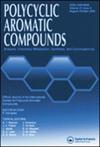修饰碳量子点壳修饰的Fe3O4纳米粒子:合成、表征及其对Cu(ii)和Zn(ii)离子的高效吸附评价
IF 2.6
3区 化学
Q2 CHEMISTRY, ORGANIC
引用次数: 0
摘要
研究了纳米磁性Fe3O4@CQDs/Si(OEt)(CH2)3NH/CC/PEG-400 (Fe3O4@CQDs/NH/CC/PEG-400)吸附剂对污染溶液中Cu2+和Zn2+的吸附效果。在45 ppm浓度的Cu2+和Zn2+溶液中,考察了pH、接触时间和吸附剂用量的影响。在pH = 7、接触时间为120 min时,增加溶液浓度,吸附量增大,对Cu2+和Zn2+离子的最大吸附量分别为219.9和159.2 mg/g。根据相关系数(R2),选择Langmuir等温线和拟二阶模型。提出的吸附机理有络合物的形成、粒子间扩散、离子交换相互作用和静电相互作用。结果表明,该吸附剂可循环使用5次,去除率达91%。本文章由计算机程序翻译,如有差异,请以英文原文为准。
Fe3O4 Nanoparticles Decorated with a Modified Carbon Quantum Dot Shell: Synthesis, Characterization and Its Evaluation as an Efficient Adsorbent for Cu(ii) and Zn(ii) Ions Adsorption
The present study focuses on the adsorption efficiency of nanomagnetic Fe3O4@CQDs/Si(OEt)(CH2)3NH/CC/PEG-400 (Fe3O4@CQDs/NH/CC/PEG-400) as an adsorbent for Cu2+ and Zn2+ removal from the contaminated solutions through the adsorption technique. The effect of pH, contact time, and adsorbent dosage in the 45 ppm concentration of Cu2+ and Zn2+ solutions was also evaluated. By increasing the concentration at pH = 7 and the contact time of 120 min, the adsorption capacity increases so that the maximum adsorption capacity of Cu2+ and Zn2+ ions is 219.9 and 159.2 mg/g, respectively. Based on the correlation coefficient (R2), the Langmuir isotherm and the pseudo-second-order models were selected. The proposed mechanisms of adsorbent are the formation of complexes, interparticle diffusion, ion exchange interaction, and electrostatic interaction. The results show that adsorbent can be used in five cycles with 91% removal efficiency.
求助全文
通过发布文献求助,成功后即可免费获取论文全文。
去求助
来源期刊

Polycyclic Aromatic Compounds
化学-有机化学
CiteScore
3.70
自引率
20.80%
发文量
412
审稿时长
3 months
期刊介绍:
The purpose of Polycyclic Aromatic Compounds is to provide an international and interdisciplinary forum for all aspects of research related to polycyclic aromatic compounds (PAC). Topics range from fundamental research in chemistry (including synthetic and theoretical chemistry) and physics (including astrophysics), as well as thermodynamics, spectroscopy, analytical methods, and biology to applied studies in environmental science, biochemistry, toxicology, and industry. Polycyclic Aromatic Compounds has an outstanding Editorial Board and offers a rapid and efficient peer review process, as well as a flexible open access policy.
 求助内容:
求助内容: 应助结果提醒方式:
应助结果提醒方式:


